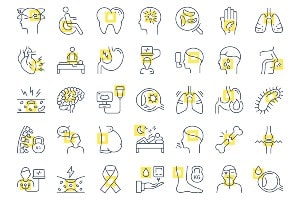About Chewing Tobacco (Smokeless Tobacco)

Learn about the disease, illness and/or condition Chewing Tobacco (Smokeless Tobacco) including: symptoms, causes, treatments, contraindications and conditions at ClusterMed.info.
Chewing Tobacco (Smokeless Tobacco)

| Chewing Tobacco (Smokeless Tobacco) |
|---|
Chewing Tobacco (Smokeless Tobacco) InformationCancer risk and chewing tobaccoUsers of snuff and chewing tobacco are at an increased risk for certain types of cancer, most notably cancer of the oral cavity including cancers of the:
Chewing tobacco facts
Other health risks of chewing tobaccoThose who use chewing tobacco have an increased risk of:
Is chewing tobacco safer than cigarette smoking?Chewing tobacco has been widely marketed as a way for cigarette smokers to use tobacco in smoke-free areas, so it is safer for other people because they are not exposed to secondhand smoke. However, in 1986, a statement from the U.S. Surgeon General concluded that users of chewing tobacco should know that chewing tobacco "is not a safe substitute for smoking cigarettes." Chewing tobacco contains nicotine, which is highly addictive, as well as a number of known cancer-causing chemicals. Any form of tobacco use poses an increased risk of developing cancer, and no level is considered safe. While the risks of getting cancer from chewing tobacco are lower than those associated with smoking cigarettes, the health risks of chewing tobacco are very real and potentially fatal. Chewing tobacco use also has not been shown to be helpful for smokers who want to quit smoking. What are the health risks of chewing tobacco?A number of significant health risks are associated with the use of chewing tobacco. What is being done to reduce the use of chewing tobacco?Parents are encouraged by health care givers, school authorities, and public health officials to include the topic of chewing tobacco use when they discuss the hazards of any tobacco use with their children, especially teen aged children. It is better never to start than try to stop the addictive tobacco (nicotine) habit in any form. Legislation has been enacted to help reduce the number of people who use tobacco products and reduce adverse health risks associated with tobacco use. The Family Smoking Prevention and Tobacco Control Act of 2009 gives the Food and Drug Administration (FDA) the power to regulate tobacco products in the U.S., which will allow for increased regulation of marketing and advertising of tobacco products, including chewing tobacco. In 2015, San Francisco became the first US city to ban the use of smokeless tobacco at sporting events, including AT&T Park, home of the city's Major League Baseball team, the Giants. What is chewing tobacco?Chewing tobacco is sometimes known as chewing tobacco or spitting tobacco. It is available in two forms, snuff and chewing tobacco. Both types of chewing tobacco are held in the mouth inside the cheek or between the cheek and gum. Snuff and chewing tobacco are commonly available in tins or pouches; popular brand names include Skoal and Copenhagen. Snus (pronounced like "snoose") is a finely ground form of snuff that originated in Norway and Sweden that comes in small tins. The amount of snuff placed in the mouth is referred to as a pinch, dip, lipper, or quid. A portion of chewing tobacco is referred to as a plug, wad, or chew. Chewing tobacco is known to contain at least 28 cancer-causing chemicals, medically known as carcinogens. The main carcinogens in chewing tobacco are the tobacco-specific nitrosamines (TSNAs). Some of the other cancer-causing agents found in chewing tobacco are formaldehyde, acetaldehyde, arsenic, benzopyrene, nickel, and cadmium. Many people mistakenly believed that snus is a safe form of chewing tobacco because it is steam-heated rather than fermented when produced in Norway or Sweden, causing it to have fewer nitrosamines. However, snus still contains a number of cancer-causing chemicals. Snus made in America is not necessarily processed in the same way as in Norway or Sweden. Nicotine is also found in snuff and chewing tobacco, like all tobacco products. Although nicotine is absorbed more slowly from chewing tobacco than from cigarettes, 3 to 4 times more nicotine is absorbed from chewing tobacco than from a cigarette, and the nicotine from chewing tobacco remains longer in the bloodstream. Nicotine is the substance responsible for tobacco addiction. Chewing tobacco is not the same thing as chewing cigarettes. Chewing cigarettes (also termed e-cigarettes) are designed to provide nicotine in vapor to the user without burning tobacco. However, the smokeless cigarettes still provide addictive nicotine to the user and secondhand nicotine to others. What treatments are available to help people quit using chewing tobacco?Chewing tobacco is an addiction that can be overcome. As with cigarette smoking, various support systems, programs, and even prescription medications are available to help people quit using chewing tobacco. Examples of products available used to wean a person from nicotine addiction from chewing tobacco include:
|
More Diseases
A | B | C | D | E | F | G | H | I | J | K | L | M | N | O | P | Q | R | S | T | U | V | W | X | Y | Z
Diseases & Illnesses Definitions Of The Day
- Noncancerous Colloid Thyroid Nodule (Thyroid Nodules) ‐ How are thyroid nodules diagnosed?, Introduction to thyroid nodules …
- Skin, Laser Resurfacing (Laser Resurfacing) ‐ CO2 Laser Resurfacing, Complications of Laser Skin Resurfacing …
- Malignant Fibrous Histiocytoma (Bone Cancer Overview) ‐ Are there any treatments or medications that relieve bone cancer pain? …
- Double Vision ‐ Is it possible to prevent double vision?, What are the symptoms and signs of double vision? …
- Ageusia (Taste Disorders) ‐ Are taste disorders serious?, Can taste disorders be treated? …
- Autism Screening and Diagnosis ‐
- Alpha-fetoprotein Blood Test ‐ In which situations are high blood (serum) levels of AFP used as a tumor marker? …
- Polymyalgia Rheumatica ‐ How do health care professionals make a diagnosis of polymyalgia rheumatica? …
- Stump Appendicitis (Appendicitis) ‐ Appendicitis definition and facts, Are there long-term consequences of appendectomy? …
- Gonorrhea (Gonorrhea In Women) ‐ Gonorrhea facts, How is gonorrhea diagnosed?, What are sexually transmitted diseases (STDs)? …